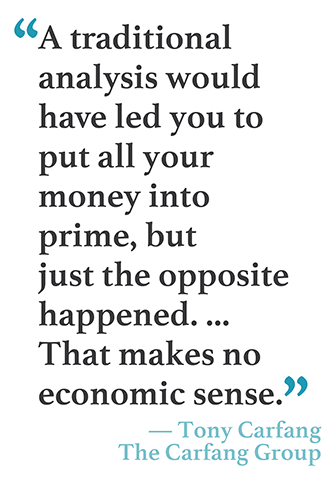
Although markets have now returned to a relatively normal state, movement in money funds bordered on irrational in March of this year. As the impacts of the Covid-19 pandemic began to sink in, volatility reached the highest levels in decades and markets went "risk off." Corporate treasurers drew down credit lines and poured cash into the seemingly safest alternatives—government and Treasury money-market funds (MMFs).
Here's how the situation unfolded: Following its federal funds rate cuts of 50 basis points (bps) on March 3 and 100 bps on March 16, the U.S. Federal Reserve took additional actions to bring confidence to volatile markets, bolstering liquidity with backstops for commercial paper and money-market funds.
On March 10, reports began coming out indicating that possible business disruption and trading bottlenecks in the commercial paper (CP) market could threaten companies' access to liquidity. The Fed responded quickly. On March 17, the Fed restarted its Commercial Paper Funding Facility (CPFF), which it had instituted during the global financial crisis of 2008 to 2009. The CPFF allows highly rated corporations to sell their CP directly to the U.S. Treasury, ensuring they will be able to roll over paper currently held by MMFs. The next day, the Fed also instituted the Money Market Fund Liquidity Facility, which provides guarantees to banks that purchase highly rated securities from MMFs.
Nevertheless, by mid-March, corporate investment managers were rapidly moving short-term cash holdings from prime MMFs to government and Treasury MMFs. ICD worked with treasury strategy firm The Carfang Group to analyze the aggregated trading activity of its nearly 400 clients during the period between March 2 and April 8. The ICD clients in the analysis span all sizes and every major industry. These companies currently manage a total of more than $215 billion in average daily balance on ICD Portal, so the data provides a fairly broad market perspective on what happened in March.
During the analysis period, flows into government and Treasury MMFs on ICD Portal rose 117 percent and 295 percent, respectively, while prime MMF assets fell 71 percent over a single week, before bottoming out on March 23. This happened even as the yield spread between prime money-market funds and government funds widened in the analysis period from 12.5 bps to a peak of 47.4 bps.
 For a week, that spread wasn't
enough to lure corporate investors back into prime MMFs. Tony
Carfang, managing director of The Carfang Group, points out that if
just $10 billion had stayed in prime funds rather than shifting to
government MMFs, those investments would have earned an additional
$830,000 per day.
For a week, that spread wasn't
enough to lure corporate investors back into prime MMFs. Tony
Carfang, managing director of The Carfang Group, points out that if
just $10 billion had stayed in prime funds rather than shifting to
government MMFs, those investments would have earned an additional
$830,000 per day.
"A traditional analysis would have led you to put all your money into prime, but with risk driving decisions, just the opposite happened," Carfang says. "The rush from prime seems to have been all about the headline risk. Effectively, financial assets of all types were being supported by the federal government, so instruments like prime funds should have been priced much closer to the level of government or Treasury funds, but instead the spread went up to 47 bps. That makes no economic sense."
What Really Happened in MMFs
The ICD analysis reveals that MMFs, as an asset class, performed flawlessly. They provided corporate investors with daily liquidity at net asset value (NAV), even as those investors' emotions led them to de-risk. Even prime funds, which directly reflect stress in the credit market, maintained market NAVs of $0.99914 at their lowest, only a $0.00086 deviation.
"These funds didn't come close to breaking the buck, and no one triggered gates or fees," says Peter Crane, CEO of Crane Data. "Never was a corporate in jeopardy of failing to get their money back on the same day. Most funds were far more liquid than required. That's a victory for prime and for money funds as a whole."
Another indication of the performance of MMFs as an asset class is its ability to absorb vast amounts of cash. Through the five-week analysis period, the market took in $782 billion in new assets.
"I think the reason why prime funds held up so well is because government funds held up so well, and that took the pressure off of prime," Crane says. "Because investors were bucketing their funds, they didn't have to hit their liquidity so hard and so fast in the prime space. They knew they had government assets, and they were raising more assets. Money was flowing in."
Some have suggested the reason MMFs held up so well is that recent money fund regulations did what they were supposed to do. However, Carfang sees it differently. "Upwards of $1 trillion left prime funds following the regulations put in place after the global financial crisis," he says. "Sure enough, it was the dearth of buyers in early March that led to the seizing up of the commercial paper markets and the resulting panic in the stock and bond markets." That's because prime funds had been the largest purchasers of CP.
A Look Back, A Look Ahead
So, what happened to drive so many investors out of prime funds?
"I think it was a confluence of events that caused people to doubt the future and sell off everything in the stock and bond markets," says Crane. "That happened, and then the same thing happened as in 2008, when even safe investments were scrutinized."
Unlike programmatic trading at banks, or hedge funds that have rigid rules for portfolio trades, corporate investment policies are generally broad in nature, giving treasury organizations a wide berth in the way they allocate short-term assets. When left up to human decision-making, the natural reaction in times of uncertainty is an additional bias toward capital preservation and away from yield. "The human element is a major factor in what we saw in the days following the Fed's March 3 move," says Carfang.
What can corporate investment managers learn from this analysis?
"The spread versus the associated risks on government and prime funds represented a significant premium over those of Treasury repo and government repo funds," says Carfang. "Reason needs to guide investors going forward, given the assurances policymakers have put in place to give confidence." Carfang would not have advised clients to put all their money into prime funds, but likewise he would not have recommended excluding prime funds from corporates' short-term investment mix. "The old investment adage of the balanced portfolio is tried and true as corporate investors find footing while the Covid-19 impact continues to unfold," he says.
Crane concurs. "Having diversity between funds and being able to move between them—regardless of which bucket springs a leak—is always a good idea," he says.
For now, the market has stabilized on all fronts. The government has shown its willingness to support money-market funds from a fiscal and monetary policy perspective, and professionals have settled from March's market chaos and the move from office to home. Corporate investment managers are currently finding balance at work, at home, and in their portfolios.
The next time chaos engulfs the financial markets, treasury teams would do well to remember the solid performance of money-market funds during the global financial crisis and the current pandemic. Historically, a balanced portfolio has been shown to optimize liquidity, safety, and returns.
See also:
- Northern Trust Shutters Money-Market Fund
- Fed Unleashes Emergency Loan Facilities
- MMF Opportunity in Volatile Markets
- 2019 Cash Management Survey: How Corporate Treasuries Are Seizing the Moment
 Justin Brimfield is
ICD's chief marketing officer. His domain expertise in treasury
spans nearly 20 years, during which time he led several growing
technology companies servicing the treasury marketplace.
Justin Brimfield is
ICD's chief marketing officer. His domain expertise in treasury
spans nearly 20 years, during which time he led several growing
technology companies servicing the treasury marketplace.
© 2024 ALM Global, LLC, All Rights Reserved. Request academic re-use from www.copyright.com. All other uses, submit a request to [email protected]. For more information visit Asset & Logo Licensing.




